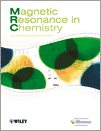Magnetic Resonance in Chemistry
Magnetic Resonance in Chemistry is a monthly peer-reviewed scientific journal covering the application of NMR, ESR, and NQR spectrometry in all branches of chemistry. The journal was established in 1969 and is published by John Wiley & Sons. The editors-in-chief are Roberto R. Gil (Carnegie Mellon University) and Gary E. Martin (Merck & Co.).
 | |
| Discipline | Chemistry |
|---|---|
| Language | English |
| Edited by | Roberto R. Gil, Gary E. Martin |
| Publication details | |
| History | 1969-present |
| Publisher | John Wiley & Sons |
| Frequency | Monthly |
| 1.731 (2018) | |
| Standard abbreviations | |
| ISO 4 | Magn. Reson. Chem. |
| Indexing | |
| CODEN | MRCHEG |
| ISSN | 0749-1581 (print) 1097-458X (web) |
| LCCN | 85647586 |
| OCLC no. | 639062734 |
| Links | |
Abstracting and indexing
The journal is abstracted and indexed in:
According to the Journal Citation Reports, the journal has a 2018 impact factor of 1.731.[1]
Highest cited papers
According to the Web of Science, the following papers have been cited most often (> 300 times):[2]
- Massiot, Dominique; Fayon, Franck; Capron, Mickael; King, Ian; Le Calvé, Stéphanie; Alonso, Bruno; Durand, Jean-Olivier; Bujoli, Bruno; Gan, Zhehong; Hoatson, Gina (2002). "Modelling one- and two-dimensional solid-state NMR spectra". Magnetic Resonance in Chemistry. 40: 70–76. doi:10.1002/mrc.984.
- Willker, Wieland; Leibfritz, Dieter; Kerssebaum, Rainer; Bermel, Wolfgang (1993). "Gradient selection in inverse heteronuclear correlation spectroscopy". Magnetic Resonance in Chemistry. 31 (3): 287. doi:10.1002/mrc.1260310315.
- Saitô, Hazime (1986). "Conformation-dependent13C chemical shifts: A new means of conformational characterization as obtained by high-resolution solid-state13C NMR". Magnetic Resonance in Chemistry. 24 (10): 835–852. doi:10.1002/mrc.1260241002.
gollark: I'm not saying everyone will stop doing art and image models will be used instead, I'm saying *commercial* art will probably switch over to image models a significant amount.
gollark: Sure. I'm questioning the commercial viability of it.
gollark: If you can get decent-looking stuff with a few iterations of prompt tweaking you're probably not going to pay another person to do it for you.
gollark: If they want art because it looks nice or they need to advertise something, say, then they'll care less about it being "real art" by humans.
gollark: If people care about art as a status signal or art for some philosophical reason they might want it to be human-made.
References
- "Magnetic Resonance in Chemistry". 2018 Journal Citation Reports. Web of Science (Science OR Social Sciences ed.). Clarivate Analytics. 2019.
- "Magnetic Resonance in Chemistry". Science Citation Index. Web of Science (Science ed.). Thomson Reuters. 2012.
External links
This article is issued from Wikipedia. The text is licensed under Creative Commons - Attribution - Sharealike. Additional terms may apply for the media files.